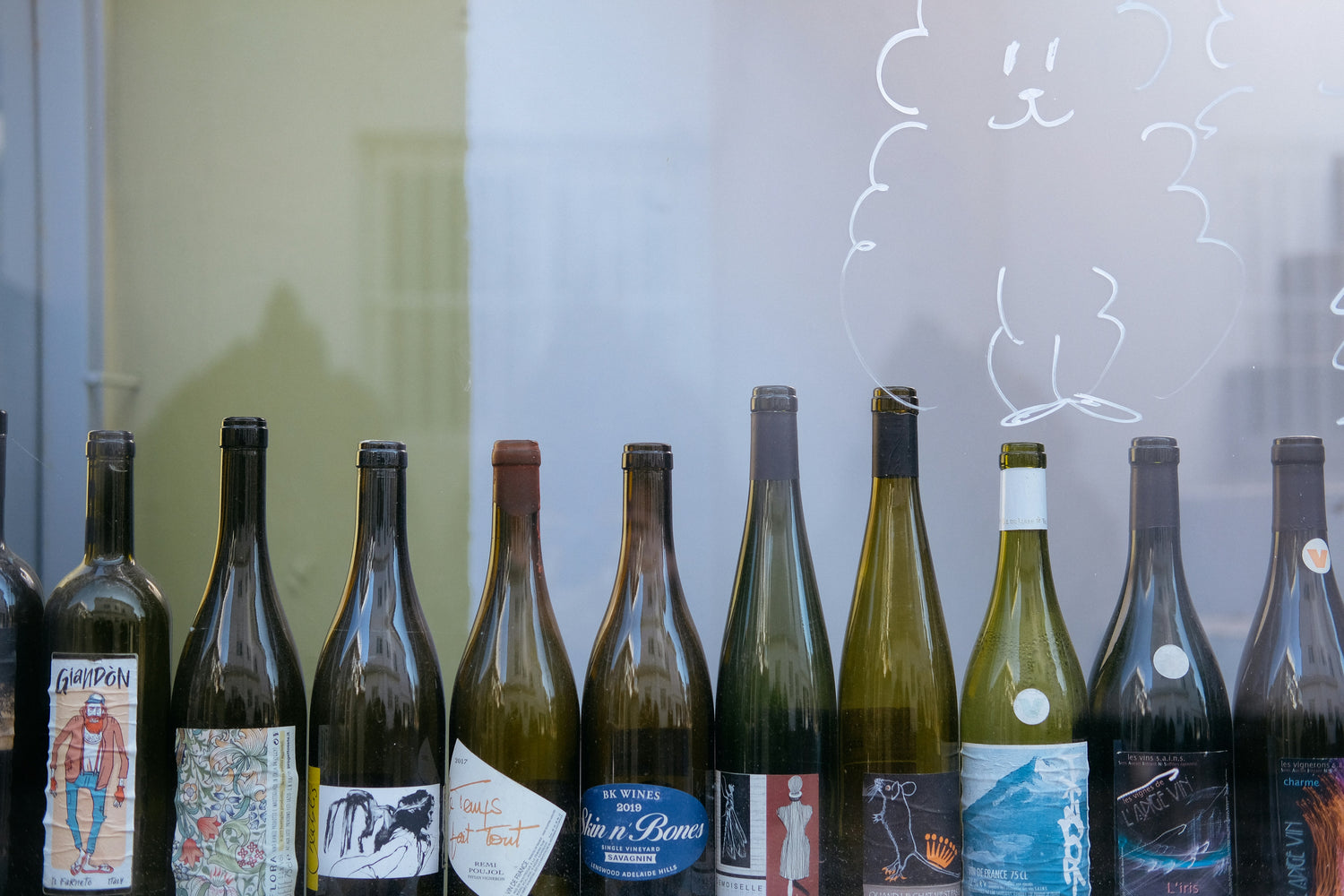
Hidden Wine Additives Exposed: From Fish Guts to Factory Chemicals
gregory Kinsman-ChauvetShare

Here's something that might surprise you - fish guts belong in wine, and it's not just a myth. Fish bladders, processed into isinglass, are just one of over 72 chemical additions that U.S. wineries can legally use. The federal government lets them add these substances without telling consumers about it on the label.
Today's commercial winemaking has taken a troubling turn. Industrial chemicals and toxic additives have become commonplace in wine production. These additives range from copper sulfate to ammonium phosphate, and they pose real health concerns. Almost every bottle of wine in the U.S. contains additives, but wineries keep their ingredient lists hidden from consumers.
Fish guts in wine might sound surprising, but it's not just a myth. Fish bladders, processed into isinglass, are used in some wines as fining agents for wine clarification.
While the UK doesn't have a comprehensive list of 72 chemical additions like the U.S., up to 50 additives can be legally used in winemaking. However, the UK regulations focus more on allergen labelling and transparency.
Let's take a closer look at what goes into commercial wines. We'll see why winemakers use these ingredients and help you find natural wines that taste great without artificial help.
The Wine Industry's Hidden Secrets
Wine stands out from other food products as one of the few drinks that don't need ingredient labels [1]. The European Union allows more than 60 different additives in winemaking [1]. U.S. regulations permit over 72 approved substances [2].
Commercial winemakers commonly use these additives:
|
Additive Type |
Examples |
Purpose |
|---|---|---|
|
Wine Preservatives |
Sulfur dioxide, Potassium sorbate |
Sterilization |
|
Fining Agents |
Bentonite clay, Isinglass |
Wine clarity |
|
Wine Stabilizers |
Copper sulfate, Citric acid |
Remove off-flavors |
|
Colour enhancers |
Mega Purple, Activated carbon |
Adjust wine color |
Commercial wineries aren't legally required to disclose these additives on their labels [3]. Most consumers don't know about dozens of additives in their wine—from sulfur dioxide that preserves to artificial colouring agents that change appearance [3].
The wine industry's resistance to transparency is clear. Discussions about ingredient listing started in the late 1970s, but wine producers have avoided putting ingredients and nutritional details on bottle labels [4]. Commercial wineries want to hide differences between batches and sell the same-tasting product year after year [5].
Winemakers use additives to meet mass production needs rather than improve quality. These substances help create consistent products, regardless of the grape quality or natural variations [5]. All the same, natural winemaking shows these additives aren't essential to make excellent wine—they aid mass production and cost-cutting [6].
How Commercial Wineries Change Wine
"I cook with wine, sometimes I even add it to the food." — W. C. Fields, Renowned American comedian and actor
Commercial wineries use many chemical additives to change wine's basic characteristics. Here's a detailed look at common wine modifications:
|
Modification Type |
Common Additives |
Purpose |
|---|---|---|
|
Wine Color Enhancement |
Mega Purple, Ultra Red |
Darken wine color [7] |
|
Chemical Treatment |
Copper sulfate, PVPP |
Remove off-flavors [8] |
|
Taste Modification |
Tartaric acid, Calcium carbonate |
Adjust acidity [9] |
|
Wine Clarification |
Isinglass, Gelatin, Egg albumen |
Remove sediment [10] |
Winemakers use concentrated grape products like Mega Purple at rates between 0.04% to 0.5% to create artificial colouring [7]. These additions happen after fermentation, mostly in wines priced under £15.88 per bottle [7].
Industrial chemicals like PVPP, a microplastic, remove unwanted flavours extensively [8]. This practice creates environmental concerns as these substances end up in the food chain [8].
Winemakers artificially acidify wines picked too late to modify taste [11]. They also add water to reduce alcohol content when needed [11]. These practices are part of wine acidity adjustment and wine alcohol content control techniques used in conventional winemaking.
The wine clarification process raises ethical concerns, especially with wines filtered through animal products. Gelatin from pig skin serves as the most common fining agent, with just one ounce clarifying 1,000 gallons of wine [10]. Fish bladder isinglass, milk casein, and egg whites also help remove sediment commonly [10].
Why Wine Makers Add These Chemicals
Mass production has transformed traditional winemaking methods. Large wineries now face pressure to keep their output steady while dealing with rising costs [12]. Production costs have jumped 5% to 20% from suppliers [12], which forces wineries to depend on additives.
The need for mass production makes wineries pick all grapes, no matter their ripeness or quality [13]. Chemical additives become the go-to solution to fix flaws and keep the taste consistent. Rising energy and raw materials prices have forced wineries to charge more or cut costs elsewhere [14].
Commercial producers' biggest challenge is to make their wines look and taste the same. Winemakers turn to additives like Mega Purple, a wine concentrate so intense it leaves glass stained, to achieve consistent colours [13]. This lets them make decent wine even from lower-quality grapes.
Economic pressure has made cost-cutting common in wineries. Worker shortages in production and delivery have undoubtedly affected operations [12]. Many producers choose synthetic over organic treatments to curb these challenges, though this choice can hurt their vineyard's health [15]. Some wineries now get their grapes from less prestigious places - switching from coastal to inland areas - to protect their profits [16].
This push for sameness and cheaper production creates technically flawless wines but lack character [15]. This factory-style approach clashes with traditional methods that value nature's variations and each region's unique terroir.
Choosing Better Wine Options
The quest to find additive-free wines begins with label reading. Note that terms like "organically grown," "biodynamic," or "low-intervention wines" show minimal chemical use [17]. Wines with organic labels must contain under 10 parts per million of sulfites [18].
Several importers focus on natural wines. Louis/Dressner Selections provides prominent traditional options, and Percy Selections works with avant-garde producers [19]. Selectionaturel partners with some of Italy's finest natural wine producers [19].
Reading wine labels
Natural wines have unique names and modern, colourful labels [20]. These key indicators appear on wine bottles:
|
Conventional Wines |
Natural Wines |
|---|---|
|
Contains sulfites warning |
Under 10ppm sulfites |
|
Standard brand names |
Artisanal producer names |
|
Mass production regions |
Specific vineyard sites |
|
Added sugar content |
No sugar additions |
Finding additive-free wines
Ruby red wines pack the highest antioxidant content - up to eight times more than white wines [21]. Pinot Noir leads with up to 16 milligrams per litre of resveratrol [21]. Orange wines deliver similar antioxidant benefits to reds when grape skins stay in contact during fermentation [22].
Biodynamic certifications guarantee truly natural options. These wines skip commercial yeast and create self-sustaining ecosystems [18]. Many artisanal producers follow organic or biodynamic viticulture practices without certification since the process can get pricey [23].
Natural Wine: A Pure Alternative
"Wine improves with age. The older I get, the better I like it." — Anonymous, Unknown
Winemaking dates back 9,000 years. The craft started with just two simple ingredients: grapes and time [24]. Traditional winemakers use eco-friendly farming methods. Their vineyards thrive as complete ecosystems with natural pest control and rich biodiversity [4].
Traditional winemaking methods
Natural wine production follows age-old practices that work with nature's rhythm. The process starts with hand-picked grapes that ferment using only native yeast strains found on grape skins [25]. Wines spend 4-14 days fermenting in open-air containers [24]. Some wines undergo malolactic fermentation for 3-6 months to develop a smoother taste [24].
|
Traditional Methods |
Commercial Methods |
|---|---|
|
Hand-harvested grapes |
Machine harvesting |
|
Wild yeast fermentation |
Added commercial yeast |
|
Natural pest control |
Chemical pesticides |
|
Minimal intervention |
Heavy processing |
No artificial additives are needed
Natural wines show that great wine doesn't need additives. These bottles contain nowhere near the sulphites of regular wines - just 10-100 parts per million compared to 350 ppm [26]. This approach creates wines that capture their origin's true character [27].
Wines without additives taste cleaner and purer, with no chemical aftertaste [27]. They help protect the environment by using less machinery and supporting biodiversity [28]. The results prove that exceptional wine comes from patience, skill, and respect for nature - not artificial ingredients [25].
Conclusion
Of course, the wine industry uses additives because of profit-driven mass production, not necessity. Traditional winemaking techniques have created exceptional wines for thousands of years without chemicals. These additives serve commercial interests instead of wine's quality or consumer health.
Natural wines paint a different picture. They're made with grapes and time, delivering pure flavours showcasing their origins. They prove that great wine doesn't need artificial help - careful growing, patience, and respect for time-tested methods.
The difference between natural and commercial wines becomes evident once you know what goes into each bottle. Mass-produced wines contain dozens of hidden additives, but natural wines give you complete transparency. These pure wines taste better and support sustainable winemaking practices and small-scale producers.
Wine lovers ended up deserving to know what's in their glass. This knowledge helps us make more intelligent choices about our wine. Natural wines show exceptional taste come from quality grapes and skilled craftsmanship - not from a lab full of artificial additives.
References
[1] - https://nomadicsommelier.com/additives-in-wine/ [2] - https://www.wineenthusiast.com/culture/industry-news/new-eu-wine-label-regulations/?srsltid=AfmBOopxRZLaNuyDYdnDrI352JxpY1IONMlPHdEov1aHiPR-w1yUXL4k [3] - https://thegrapevinemagazine.net/2024/11/why-u-s-wine-labels-leave-consumers-in-the-dark/ [4] - https://www.independent.co.uk/extras/indybest/food-drink/wine/best-natural-wines-uk-b2315511.html [5] - https://drinktinto.com/blogs/wine-wisdom/wine-additives?srsltid=AfmBOoooyJF3rMvUDtskb9wag5T4R4r35Vm8r2z6ePJ0adp70zdR84Tr [6] - https://mysa.wine/blogs/no-mog-blog/legal-additives-in-commercial-winemaking?srsltid=AfmBOoqJVTTOGqTLPZlmdsSe1_M7dyTT5r0cpzrzM-t-uuqM8qu05K5s [7] - https://winemakermag.com/article/1557-perfecting-protecting-wine-color [8] - https://www.winescholarguild.com/blog/wine-education-careers/a-look-at-ingredients-in-wine [9] - https://winefolly.com/deep-dive/wine-additives/ [10] - https://en.wikipedia.org/wiki/Vegetarianism_and_wine [11] - https://winefolly.com/deep-dive/wine-making-processes-affect-wines-flavor/ [12] - https://www.forbes.com/sites/jillbarth/2021/11/03/material-shortages-and-supply-chain-challenges-impact-the-wine-industry/ [13] - https://pullthecork.co.uk/what-do-you-know-about-wine-additives/ [14] - https://sommelierschoiceawards.com/en/blog/insights-1/challenges-faced-by-the-wine-industry-in-2024-whats-the-reason-behind-the-decline-1044.htm [15] - https://www.winescholarguild.com/blog/tasting-trends/wine-commodity-or-artisan-product [16] - https://www.winebusiness.com/wbm/article/277945 [17] - https://www.laithwaites.co.uk/jsp/contenthub/uk/article.jsp?content=what-is-natural-wine [18] - https://www.winespectator.com/articles/wine-pesticides-chemicals-additives-organic-biodynamic [19] - https://www.gq-magazine.co.uk/lifestyle/article/guide-to-natural-wine [20] - https://www.theguardian.com/food/2019/jul/12/natural-selection-four-of-the-best-additive-free-wines [21] - https://www.health.com/nutrition/healthiest-wine [22] - https://www.thedrinksbusiness.com/2024/05/the-healthiest-wines-to-drink-according-to-a-dietitian/ [23] - https://www.goodwineonline.co.uk/product-category/free-from-wines/?srsltid=AfmBOopKgq1oGxkxap12ExVeTjma47FI9PqEaFsodZuKzYiYDkFu2bhT [24] - https://www.dryfarmwines.com/blogs/a-matter-of-taste/how-is-natural-wine-made?srsltid=AfmBOooGXijQDgC3HeEX8BKEbDEDFiZre3HqWn8hd7kCELuGsZQ5-PjX [25] - https://theconversation.com/natural-wines-how-are-they-made-and-whats-the-deal-with-sulfites-an-expert-explains-174879 [26] - https://www.foodandwine.com/wine/what-is-natural-wine [27] - https://www.vinissimus.co.uk/en/content/natural-wines/?srsltid=AfmBOorlO3HYV0c1k_XfgAdJbc3Xg5PG1kLZOJ2E18Ym_JIVdJk4aKzg [28] - https://theitalianwineshop.co.uk/a-guide-to-natural-wine/

